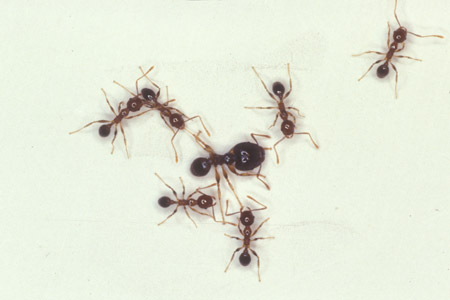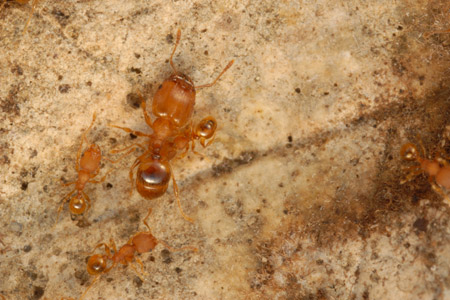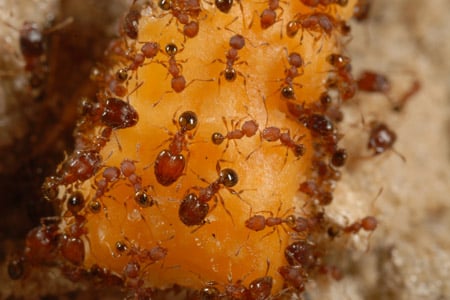Active Seasons




Big-Headed Ant Appearance and Size Facts
The aptly named species of big-headed ants get their title due to their distinctively large heads relative to their body size in the major soldier. Their bodies range from light to dark brown, and they possess a distinctive two-node waist, with a thin segment connecting the abdomen to the thorax and a separate node on the abdomen. While they may seem unassuming, don’t let their appearance fool you, as these tiny creatures can cause significant disruptions in both natural habitats and man-made settings.
Identifying Big-Headed Ants From Other Ants
These small ants, measuring around an eighth of an inch, have major workers with disproportionately large heads relative to their bodies, while minor workers have smaller heads. The major workers are usually the easiest to distinguish from other ant types because of their distinctive shape.
We provide ant control for big-headed ants in the following locations and their surrounding areas:

Behavior and Habitat of Big Headed Ants
Despite their diminutive size, big-headed ants can be a nuisance and cause various types of damage. They are omnivores, and their diet includes both plant material and other insects, making them versatile foragers. In the outdoors, they feed on seeds, honeydew, and small insects.
Indoors, they are attracted to sweet foods and can contaminate pantry items. One of the most concerning aspects of their behavior is their attraction to electrical equipment. Their habit of nesting near electrical outlets and circuit boxes can lead to short circuits and equipment malfunctions, posing potential fire hazards.
Big-headed ants are aggressive and can displace native ant species, impacting the balance of local ecosystems. Their sheer numbers and rapid reproductive capabilities contribute to their invasive nature, making them a formidable pest in both residential and commercial settings.

Signs of Infestation of Big Headed Ants
Big-headed ants can often be found nesting in soil, under rocks, logs, or debris outdoors, and indoors near electrical outlets or in wall voids. Their erratic foraging behavior sets them apart, as they do not follow well-defined trails like some other ant species. Paying attention to these key features will aid in accurately identifying big-headed ants and implementing appropriate pest management measures if necessary.
Big-headed ants also form “boneyards” made of soil, dirt, debris, and dead insect parts. Big-headed ants often excavate this material through pavers, driveways, and even through baseboards. For this reason, sometimes big-headed ants can be misidentified as subterranean termites.

Tips for Prevention of Big Headed Ants
Good housekeeping is a great preventative measure against a plethora of pests, including big-headed ants. Regularly clean up spills and food crumbs, keeping indoor and outdoor spaces free from attractants. Store food securely in airtight containers and promptly clean pet food bowls after feeding. Trimming vegetation away from your home’s exterior denies ants potential bridges to access buildings.
Next, address moisture issues. Repairing leaks and ensuring proper drainage, reduces areas of attraction for ants. Remove firewood, construction materials, and other appealing items away from your house’s foundation, as they can provide nesting opportunities.
Finally, ensure that pest points of entry are sealed. This means checking for cracks around your home’s exterior; keep an eye out for even the smallest gaps in screens, door sweeps, and around windows! Ants can sneak in the smallest crevices, so don’t neglect to seal even small holes.
Getting Rid of Big-Headed Ants
While prevention methods can go a long way, what do you do if you already have an active big-headed ant infestation? DIY treatments can be ineffective and unsafe, so the best route is to work with a professional ant control team, like the one at Hulett. Our GreenPro- and QualityPro-certified technicians are trained by board-certified entomologists, so are the experts at identifying, treating, and preventing big-headed ants.
Effective Big-Headed Ant Control Solutions
Don’t wait to treat pest infestation, call us at Hulett Environmental Services! Our experienced pest control experts are here to ensure that big-headed ants stay gone from your property for good. Count on Hulett’s pet-friendly targeted ant treatments to eliminate them at the source so you, your family, and your belongings all stay protected from pests. Schedule your free pest control inspection today!



